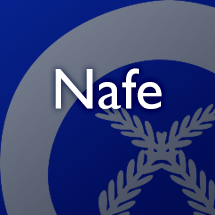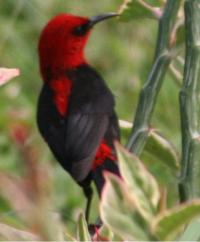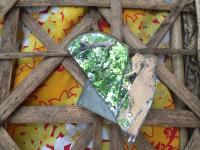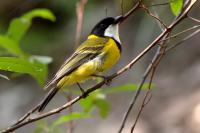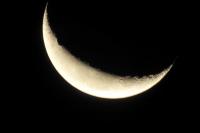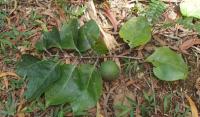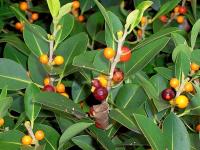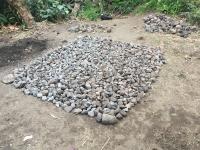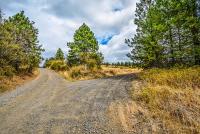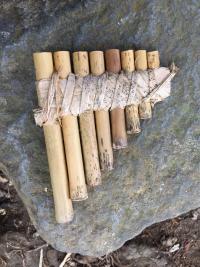An example search has returned 100 entries
-akupwɨn
-arpikou
ia-keri tapou sei nerei
Kamsiwi
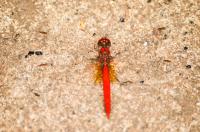
Scarlet Percher
Example: Photo by givernykate / iNaturalist, License: CC-BY-NC via inaturalist.org
bookmarkkaruarua
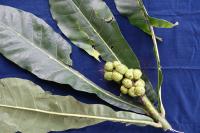
n. type of flowering plant (collection: Michael J. Balick #5143)
Example: Use this plant to stop the rain, take 4 tips of the plant’s branch and place them in a cross formation, with the tips pointing N, S, W, E, wash them in sea water, and then call for the rain to stop. Hang these tips in a tree with rope for five days. Stem used to weave roof rafter to attach coconut fronds to stick. Young men hunting in bush with slingshots, when run out of stones, use these young fruits to hunt birds.
bookmarkkarwase
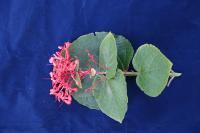
n. type of flowering plant (collection: Michael J. Balick #5120)
Example: When parents go away to a feast or garden, children take a pile of soil 12 in. diameter, put this flower on top, surround wth some ashes and then hide in the house to wait to see if the dwarf spirit appears (Karwase Haruase). Sometimes the spirit will come and then scare the children. Ancestors used these spirits and games to teach children to stay together and not wander alone. As the dwarf spirit will take you.
bookmarkkiri

Moorish idol
Example: Photo by Ian Shaw / iNaturalist.org, License: CC BY-NC 3.0 via Fishes of Australia
bookmarkkon kory

konuwak

Coral grouper, coral rock grouper
Example: Photo by J. E. Randall, License: CC BY-NC 3.0 via Fishes of Australia
bookmarkkorkwao tanna

kuanasenash

n. type of flowering plant (collection: Michael J. Balick #5166)
Example: For the kastom ceremonies, this can provide the face paint color yellow. Cut open the ripe fruit and paint directly with this. Prior to artificial colors, people used this for yellow and Bixa orellana for red to paint faces and skin.
bookmarkkuanuares
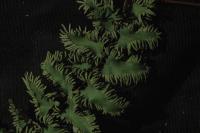
kwanarai
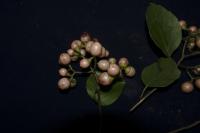
[kwanəraj] n. tree, 6-7 m tall (collection: Gregory M. Plunkett #3101)
Example: People use this plant as a medicine to treat bad knees. Peel the bark, take 1 handful and put it in a cup of water until the water becomes black. Drink it 3x daily as needed until the knee pain disappears and the knee heals. Children use the seeds as a glue in school work.
bookmarkmarawta

Bluelined squirrelfish, Tahitian squirrelfish
Example: Photo by Jeffrey T. Williams / Smithsonian Institution, License: CC BY-SA 3.0 via Fishes of Australia
bookmarkminin akwes

Brown surgeonfish
Example: Photo by David Burdick / via guamreefli License: CC BY-SA 3.0 via Fishes of Australia
bookmarknahnen
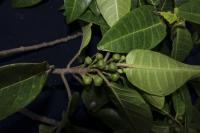
[na̤:nɨn] n. well branched tree, 8 m tall (collection: Gregory M. Plunkett #3086)
Example: The stems of this plant are one of the best firewoods; use the embers to light a person’s tobacco pipe. People know that when this plant has ripe fruit, it is time to hunt the flying fox near this tree.
bookmarknanghervk
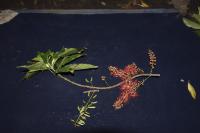
naskou
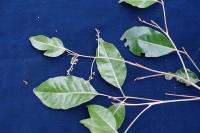
naskou

natuan
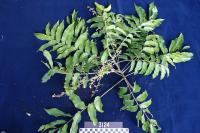
n. large tree, 10-14 m tall (collection: Gregory M. Plunkett #3124)
Example: The wood of this plant smells bad. It is locally called a type of "stink wood." When young children get circumsized in kastom ways, to change the leaves for their bandage, take off the bark of this stem, take the inside part and scrape it--mix a handful of hte scrapings with grated coconut, put it together in a leaf, put it on the fire, heat it, when the coconut is browned, squeeze it together to get the "milk" that is yellow in color. When young children swim in saltwater to dry the cut from the circumcision, squeeze this on that area to help heal it. Another use is to tr
bookmarknaurapag
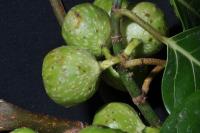
nauri
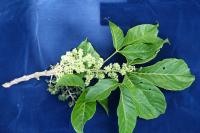
n. type of flowering plant (collection: Michael J. Balick #5118)
Example: Young stems are used to support the roof of ther house. Use yellow sap for glue. Fruits and flowers eaten by flying fox. Same effect as poison tree, they do not fly correctly, often falling and can be harvested to eat.
bookmarknefara
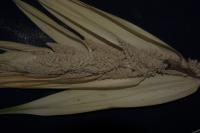
[nafare] n. tree growing in disturbed forest area along kwataren kastom road. (collection: Gregory M. Plunkett #3095)
Example: The leaves are woven to make mats, hats, baskets, fans. When pollen is released from the flower it is said that fish in the sea are healthy. The roots are used for tying things, pound pieces of root and strip them off and weave into rope. A person can cut a root in a way that makes a brush to paint grass skirts and other objects. This rope can also be used to tie various leaves that are used to cover lap-lap. The leaves can be harvested, the fiber removed and woven into rope.
bookmarknemrapep

nikinapus
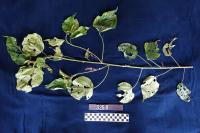
n. shrub, 1 m tall (collection: Gregory M. Plunkett #3258)
Example: A sharpened stick made from this plant is used to take the husk off of coconuts. The wood of this plant is used to make a child’s bow--carve the bark off and bend it with a string made from the banyon (Ficus) tree to both ends of the bow.
bookmarknoawatikerehy
noufoua

nuamera
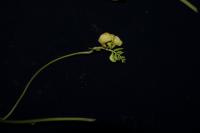
[numire] n. vine on pipturus tree, growing at edge between forest and garden of sweet potato and taro. (collection: Gregory M. Plunkett #3147)
Example: This is used as a medicine to treat babies and children with fever. Take 1 handful of leaves and squeeze the "juice" from them into a cup, add a small amount of water, just enough to dilute the strong taste of the leaf liquid. Drink 3 or 4 times a day until fever is reduced. This liquid is also good for people who have done heavy work or who are old, as it is said to strengthen the veins. So, if a person is feeling weak, they can drink a few cups of this preparation. The name "Nuamera" refers to "live veins," meaning that it will make your veins come alive ...
bookmarknuckuck
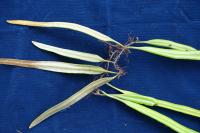
nɨpkɨpki
nɨsori
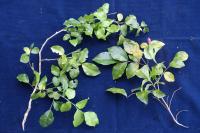
Pawpawuk
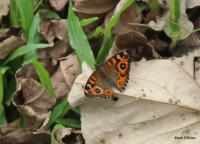
Meadow Argus
Example: Photo by obinfiji / iNaturalist, License: CC-BY-NC via inaturalist.org
bookmarkpenesu

Rivulated parrotfish, surf parrotfish
Example: Photo by Rick Stuart-Smith / Reef Life Survey, License: CC BY 3.0 via Fishes of Australia
bookmarkpirei pirei

sap sap

n. herb, 1 m tall (collection: Gregory M. Plunkett #3146)
Example: The leaves of this plant are used as a styptic, to reduce blood flow from a wound and promote faster healing of a sore. If a person has a sore or fresh cut that is oozing, the leaves are mashed and their "juice" is put directly on the affected area, twice daily until the wound is healed.
bookmarkTakiaew sei tasi
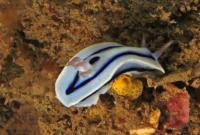
Loch’s Chromodoris
Example: Photo by tonydiver / iNaturalist, License: CC-BY-NC via inaturalist.org
bookmarkteren

n. type of flowering plant (collection: Michael J. Balick #5152)
Example: Leaf used to cover boils on skin. Mash leaf slightly and cover boil. Leaf pulls out liquid from boil. Use this for 3 days, changing the leaf 2x daily. Young plants (branch) for toothache to reduce pain. Boil in water and wash painful area. Use as needed until pain subsides. Also can collect insects in dried stems and use these to feed chickens. (Hymenoptera).
bookmarktikinau asori
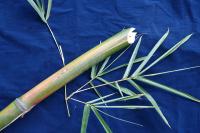
tukraus

n. branched tree, growing next to Ianarawia ("high hill") settlement (village of Philip Wahe). (collection: Gregory M. Plunkett #3153)
Example: The leaves of this plant are used by women to make grass skirts. Slice the leaf lengthwise, fold or roll them up, put to dry in sun until it becomes white. At that point it is used to make the grass skirt.
bookmarktɨmri
yangawhir ~ yaniawir

yapha iwis
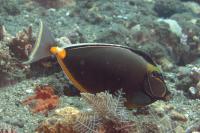
Orangespine unicornfish
Example: Photo by Mark Rosenstein / iNaturalist.org, License: CC BY-SA 3.0 via Fishes of Australia
bookmark